Nakuru is a beautiful city located in Kenya. It is home to many birds, seen in its lush forests, lakes, and other natural habitats. The variety of species includes waterfowl, raptors, and songbirds.
The city is also a popular destination for birdwatching, as it has some of the best birdwatching spots in the country. Birdwatchers from all over the world come to Nakuru to witness the diversity of species and the beauty of the birds in their natural habitat.
Nakuru is also home to many conservation efforts, which help to protect the diverse bird population.
23 Birds to Watch in Nakuru
Nakuru is a city in Kenya famous for its rich wildlife and natural beauty. One of the main attractions of Nakuru is Lake Nakuru, a sizeable alkaline lake that hosts millions of flamingos and other water birds.
Here are 23 birds to watch in Nakuru that will make your visit unforgettable.
1. Flamingo
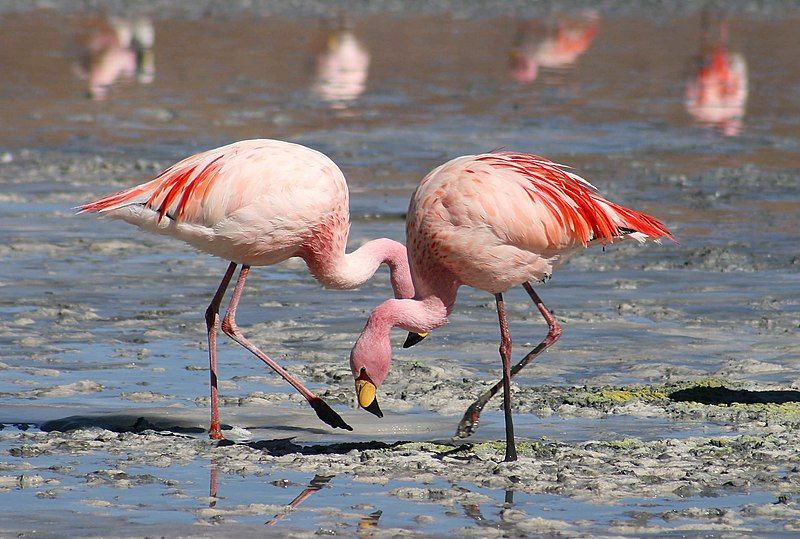
Flamingos, also known as flamingoes, are a unique type of bird found in the family Phoenicopteridae and are the only existing species in the order Phoenicopteriformes. They are found throughout the Americas, with two species native to Africa and Eurasia.
Flamingos are known for their social behavior, often forming large flocks of birds called “flamboyance.” Usually, the “se flamboyances are made up of hundreds of flamingos, sometimes even up to thousands.
Additionally, flamingos are recognized by their long legs and curved necks, usually found in shallow lagoons and mudflats. They have a distinct diet, which consists mainly of brine shrimp and blue-green algae, and they also eat a variety of other tiny aquatic organisms.
They use their specialized beaks to filter out food particles from the water. Furthermore, flamingos are highly territorial and aggressive, so they tend to form flamboyance to protect themselves from predators.
| Kingdom | Animalia |
| Phylum | Chordata |
| Class | Aves |
| Order | Phoenicopteriformes |
| Family | Phoenicopteridae |
2. Grey-crowned Crane
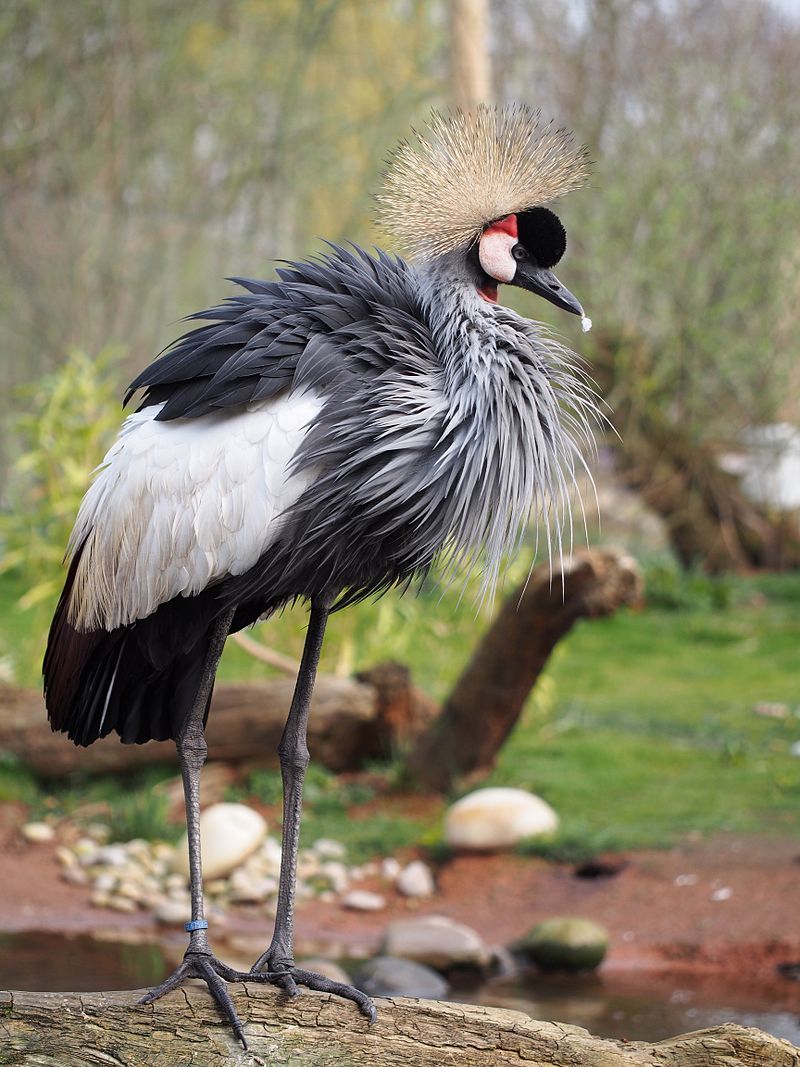
The Grey Crowned Crane, scientifically known as Balearica regulorum, is a majestic bird belonging to the Gruidae family. It is a large bird with a wingspan of up to 2.5 meters and a standing height of up to 1.3 meters.
It has a grey and white plumage, with a characteristic golden crown on its head.
It is native to Africa and is also known as the African Crowned Crane, Golden Crested Crane, Golden Crowned Crane, East African Crane, East African Crowned Crane, African Crane, Eastern Crowned Crane, Kavirondo Crane, South African Crane, and Crested Crane.
The Grey Crowned crane is an omnivore, eating both plant and animal matter.
Its diet comprises grains, grasses, worms, insects, reptiles, and small mammals. It is a gregarious species, often found in large flocks in wetlands and grasslands.
It is also a territorial species and uses loud calls and displays to protect its territory. The Grey Crowned Crane is a threatened species, with its population decreasing due to habitat loss, hunting, and poaching.
It is listed as Vulnerable on the IUCN Red List and is protected by CITES. It is also listed in the Convention on the Conservation of Migratory Species of Wild Animals. Conservation efforts are in place to protect this species, and its population is slowly recovering.
| Kingdom | Animalia |
| Phylum | Chordata |
| Class | Aves |
| Order | Gruiformes |
| Family | Gruidae |
| Genus | Balearica |
| Species | B. regulorum |
3. Greater Flamingo
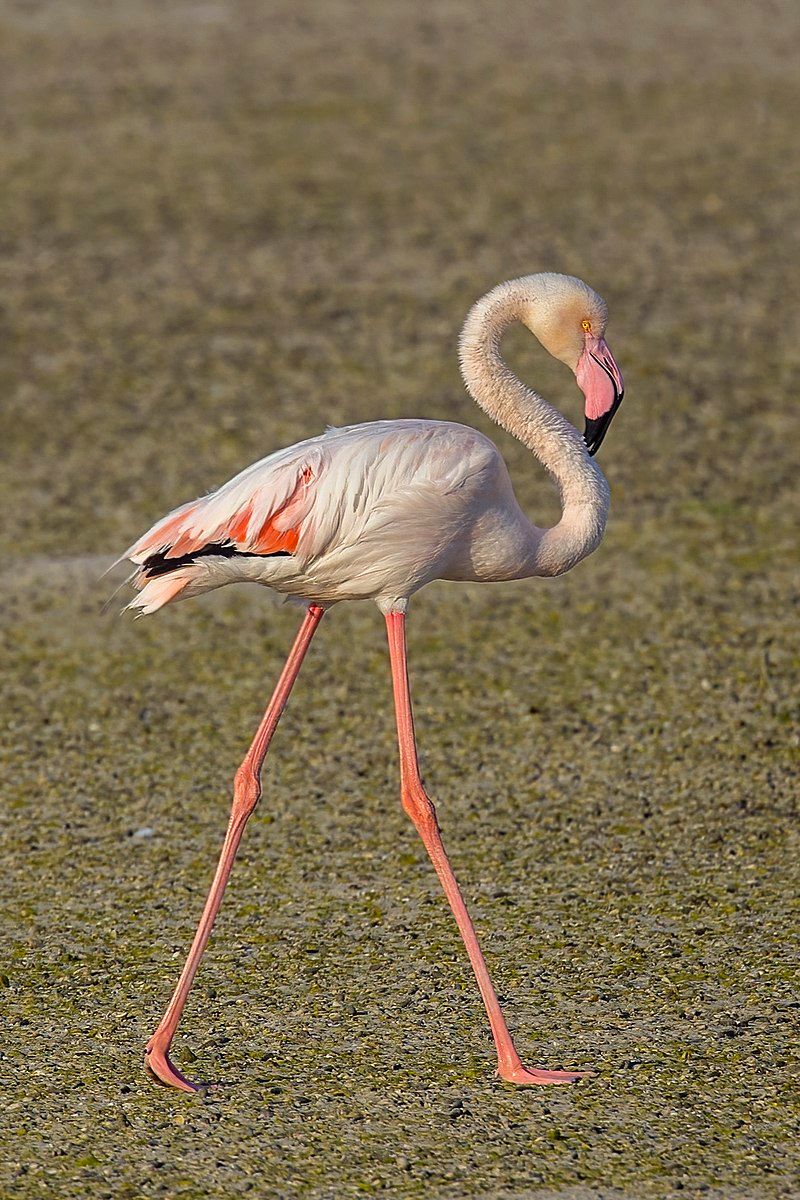
The greater flamingo is the most widespread and significant species of the family. This species of flamingo is found in various locations in the Old World. In Africa, they are found to inhabit northern and sub-Saharan regions.
In the Indian subcontinent, the Middle East, the Levant, the Persian Gulf, the Gulf of Aden, the Red Sea, and the Mediterranean regions of Southern Europe, greater flamingos are commonly sighted.
This species of flamingo typically lives in large flocks, and their habitat includes lagoons, salt pans, mudflats, and shallow lakes.
They feed on tiny aquatic organisms, such as crustaceans, mollusks, and insects, which they filter from the water using their long, curved beaks.
The pinkish hue of the greater flamingo’s flamingo is gained from the carotenoid pigments in the algae and crustaceans they eat. The greater flamingo is an iconic species in the avian world and a symbol of beauty and grace.
They are also crucial to local economies, as the birds can attract tourists. Greater flamingos are listed as ‘Least Concer” on the IUCN’Red List, but their populations are still threatened by habitat destruction, pollution, and illegal hunting.
Conservation efforts, such as creating protected areas and enforcing regulations against hunting, are essential for the future of the greater flamingo.
| Kingdom | Animalia |
| Phylum | Chordata |
| Class | Aves |
| Order | Phoenicopteriformes |
| Family | Phoenicopteridae |
| Genus | Phoenicopterus |
| Species | P. roseus |
4. Yellow-billed Stork
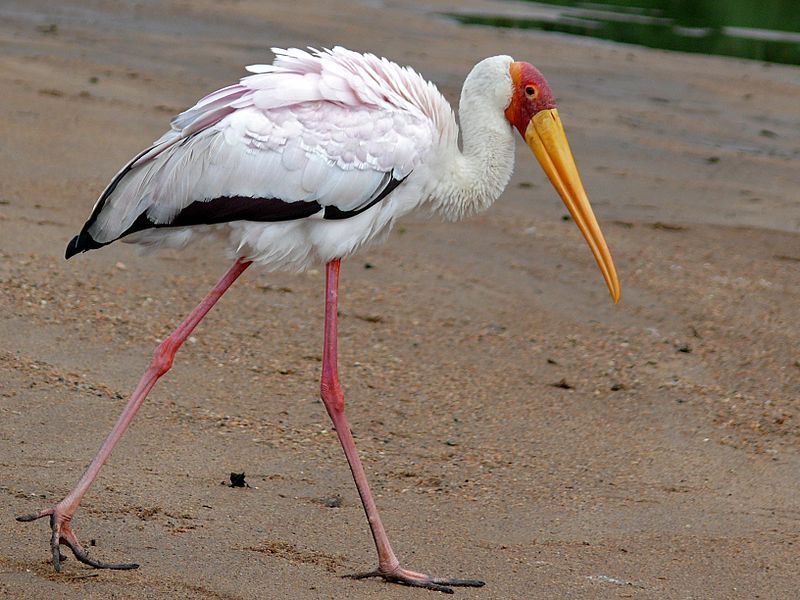
The yellow-billed stork is a large wading bird species found primarily in Africa. It is a member of the Ciconiidae family and is also known as the wood stork or wood ibis. The species is widespread in regions south of the Sahara desert and Madagascar.
The yellow-billed stork is typically found near bodies of water, such as lakes, rivers, and wetlands, where its primary diet of fish and amphibians is abundant. The species is also known for its distinctive yellow bill, as well as its long legs and neck.
The yellow-billed stork is a threatened species due to habitat destruction and overhunting. The species is protected by law in many countries and is actively monitored by conservationists.
| Kingdom | Animalia |
| Phylum | Chordata |
| Class | Aves |
| Order | Ciconiiformes |
| Family | Ciconiidae |
| Genus | Mycteria |
| Species | M. ibis |
5. Lesser Flamingo
The lesser flamingo is a species of flamingo found in sub-Saharan Africa and western India. These flamingos are typically found in these areas, yet there are reports of them being seen further north.
These sightings are considered to be rare, and the birds are usually thought of as vagrants. The lesser flamingo is one of six flamingos in the world and the smallest species. It has a pinkish-white plumage and can be identified by its distinctive bill.
This species of flamingo has a unique diet consisting mainly of shrimp and blue-green algae. Their long, curved necks help them to feed on these tiny organisms. The lesser flamingo is a migratory bird, meaning they migrate to different areas depending on the season.
They may be found in large flocks in wetlands, lakes, and shallow lagoons during summer. In the winter, they travel south for warmer temperatures and better food sources.
The lesser flamingo is an important species, as they help to keep wetlands and shallow lagoons healthy. Consuming algae and shrimp helps keep the water clean. They also provide food for larger birds and other predators in the area.
Overall, the lesser flamingo is an essential species of flamingo found in sub-Saharan Africa and western India. Although they are occasionally seen in other areas, they are generally considered to be vagrants.
They are an essential part of the local ecosystem, helping to keep the water clean and providing food for larger birds.
| Kingdom | Animalia |
| Phylum | Chordata |
| Class | Aves |
| Order | Phoenicopteriformes |
| Family | Phoenicopteridae |
| Genus | Phoeniconaias |
| Species | P. minor |
6. Pelicans
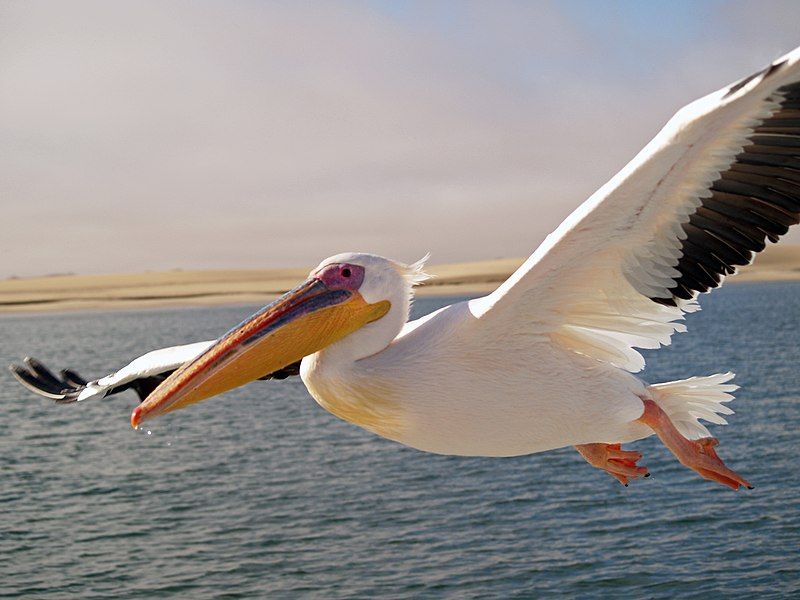
Pelicans are a prominent type of water bird belonging to the Pelecanidae family. They have a unique appearance, featuring a long beak and a large pouch in their throat. This pouch is used to catch their prey and drain any excess water from the food before they swallow it.
Most pelicans have pale-colored feathers, though there are exceptions in the form of the brown and Peruvian pelicans, which have more vibrant plumage. Pelicans are iconic birds, seen in many places with a body of water.
They are excellent swimmers and can be seen skimming the water’s surfawater’s beaks. Their impressive wingspan allows them to soar gracefully above the water for food.
Pelicans are beloved by many, providing an exciting sight for those lucky enough to witness them in their natural habitat.
| Kingdom | Animalia |
| Phylum | Chordata |
| Class | Aves |
| Order | Pelecaniformes |
| Family | Pelecanidae |
| Genus | Pelecanus |
7. Pigeons and Doves
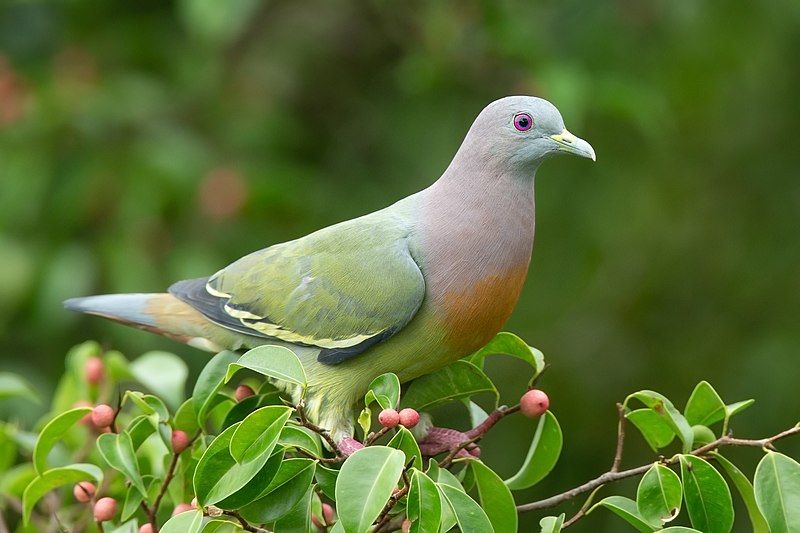
The Columbidae family comprises doves and pigeons, found in the order Columbiformes. These birds are characterized by their stout bodies, short necks, and short, slender bills. Some species also have fleshy ceres, a fleshy area above the bill.
Columbidae birds primarily feed on seeds, fruits, and plants. They are commonly found in most parts of the world and have many habitats, from arid deserts to dense forests.
These birds are known for their unique vocalizations used to communicate and establish territories. The Columbidae family is also known for its parental solid instinct; some species stay with their young until they can fly.
The Columbidae family is widely studied in ecology and behavior, as they can provide essential insights into the natural world.
| Kingdom | Animalia |
| Phylum | Chordata |
| Class | Aves |
| Clade | Columbimorphae |
| Order | Columbiformes |
| Family | Columbidae |
8. Bustards
Bustards are a bird that lives mainly in dry grassland areas and on the steppes of the Old World. They belong to the family Otididae and can vary significantly in size, ranging from 40 to 150 cm in length.
This group of birds includes two main species – floricans and korhaans – which are both large, terrestrial birds. Floricans are found throughout Europe and Asia and are slightly smaller than korhaans, native to Africa.
Both species have small heads, long legs, and long necks, allowing them to walk and feed in open grasslands and steppes. They also have potent wings, capable of robust and sustained flight.
Their feathers are typically light brown or grey, with patterns of black and white spots or stripes. Bustards are omnivorous, feeding various small animals, insects, and plants. They are also known to eat carrion or dead animals.
They are typically solitary birds, although, during the breeding season, they may form small flocks. The bustard family is considered endangered, with conservation efforts being made to protect their populations.
Their habitats are being threatened by human activities such as agricultural development and hunting, leading to a decline in their numbers.
We need to protect these birds and their habitats so that future generations can enjoy their beauty and benefit from their presence in the environment.
| Kingdom | Animalia |
| Phylum | Chordata |
| Class | Aves |
| Clade | Otidimorphae |
| Order | Otidiformes |
| Family | Otididae |
9. Larks
Larks are small, ground-dwelling birds belonging to the family Alaudidae. They are found worldwide, with the most species distributed in Africa.
In North America, only one lark species is the horned lark. Australia, Australia is home to only Horsfield’s book, usually found in open habitats such as grasslands, meadows, and deserts.
They feed on seeds, insects, and other small invertebrates; some species are migratory. Larks have a wide variety of calls and songs that can be heard during the breeding season, and they often form flocks when they migrate.
The larks’ nests are built on the ground and lined with grass and feathers. Larks are also frequently seen perched on tall plants or shrubs, using their excellent eyesight to spot potential predators.
| Kingdom | Animalia |
| Phylum | Chordata |
| Class | Aves |
| Order | Passeriformes |
| Family | Alaudidae |
10. Starlings
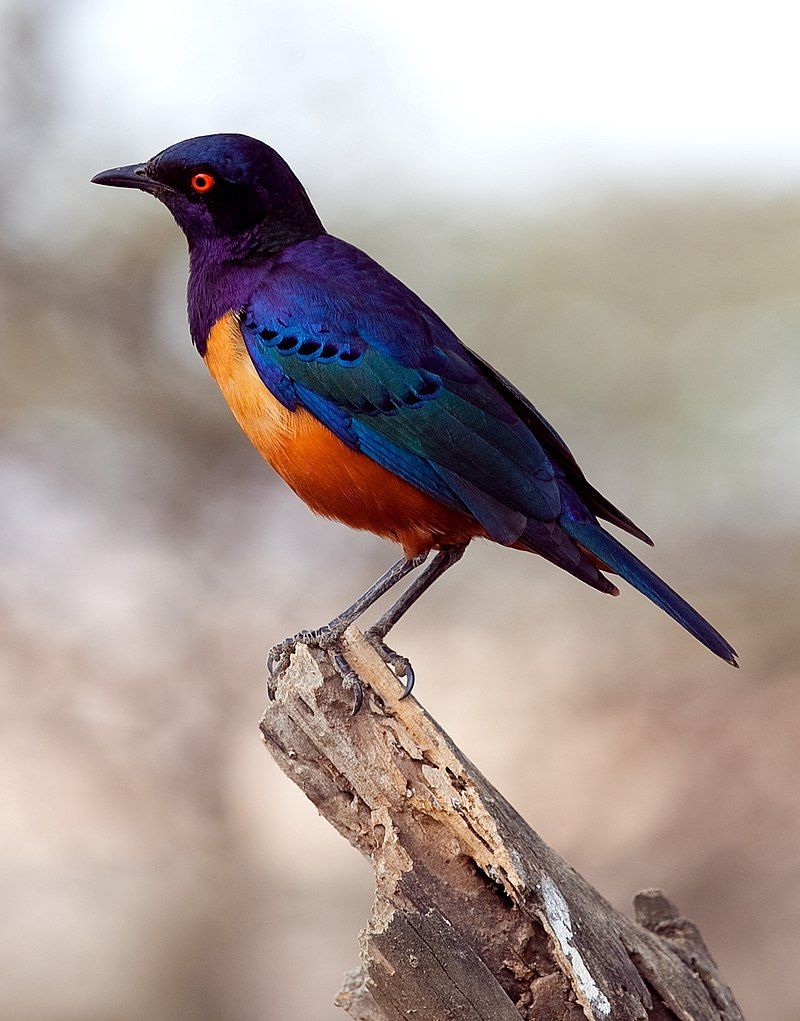
Starlings are small- to medium-sized birds belonging to the family Sturnidae. The family is named after the genus Sturnus, which comes from the Latin word for starling.
This indicates that starlings have been around for a long time and have a long history with humans. They are among the most diverse and widespread of birds and can be found in all parts of the world.
They are known for their acrobatic flying skills and musical and varied vocalizations. They are also known for their intelligence and their ability to imitate the sounds of other birds, animals, and even humans.
Starlings are essential to the avian ecosystem and are crucial in controlling pests.
| Kingdom | Animalia |
| Phylum | Chordata |
| Class | Aves |
| Order | Passeriformes |
| Family | Sturnidae |
11. Emerald-spotted Wood Dove
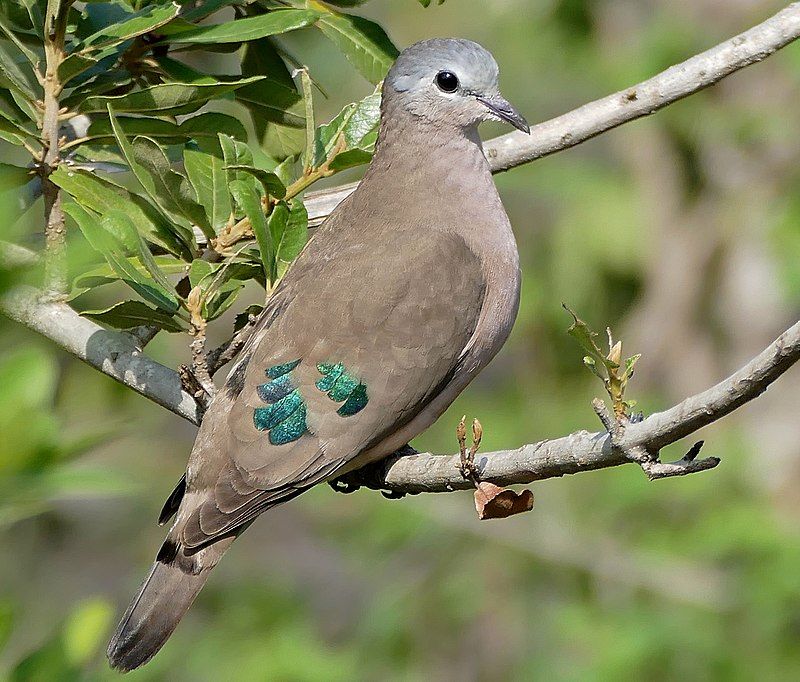
The emerald-spotted wood dove is a bird species in various habitats across eastern and southern Africa. It is a member of the Columbidae family, which includes other species, such as pigeons and doves.
This bird species prefers open, drier deciduous woodland and second-growth areas rather than evergreen rainforests or semidesert areas.
This indicates that they do not prefer areas with too much or too little moisture; instead, they prefer areas with moderate humidity levels.
The emerald-spotted wood dove is an essential species in its respective habitats, as it helps to spread seeds and aid in the regeneration of the environment.
These birds are also important for their beauty, as they have a distinct emerald-green spotted pattern on their feathers.
| Kingdom | Animalia |
| Phylum | Chordata |
| Class | Aves |
| Order | Columbiformes |
| Family | Columbidae |
| Genus | Turtur |
| Species | T. chalcospilos |
12. Marabou Stork
The marabou stork is a large wading bird native to the sub-Saharan region of Africa. It belongs to the stork family Ciconiidae and is known to be quite adaptable in terms of its habitat.
It can be found in wet and arid environments, often close to human settlements.
A typical spot to find the marabou stork is near landfill sites, a reliable food source for the bird. Given its size, the marabou stork is a formidable yet graceful creature. It is usually around 1.2 meters tall and can weigh up to 10 kg.
It has a long neck, bald head, black beak, and legs. Its wingspan, ranging from 2-2.5 meters, is also impressive. The marabou stork is a scavenger and feeds on carrion, insects, eggs, small animals, and even garbage.
It often follows vultures to feed on the carcasses they have found and will take advantage of human waste when possible. The marabou stork plays a vital role in the African ecosystem by helping clean up carrion and garbage in its environment.
It also helps control certain insect species’ populations,’ which can benefit humans.
| Kingdom | Animalia |
| Phylum | Chordata |
| Class | Aves |
| Order | Ciconiiformes |
| Family | Ciconiidae |
| Genus | Leptoptilos |
| Species | L. crumenifer |
13. Great White Pelican
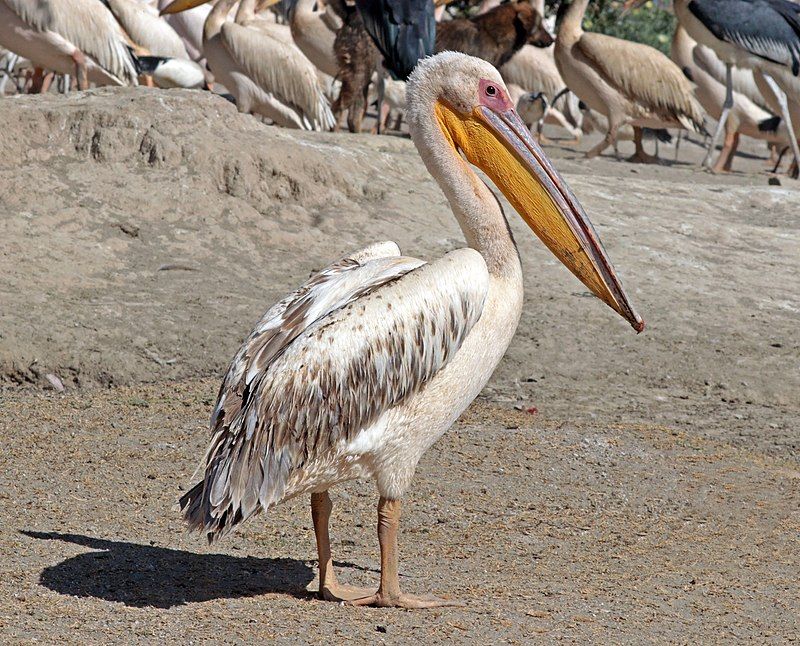
The great white pelican is a large bird that belongs to the pelican family. It is also known as the eastern white pelican, rosy pelican, or white pelican. These birds can be found across many regions, from southeastern Europe to Asia and Africa.
They often inhabit swamps and shallow lakes in these areas, where they can find plenty of food and shelter. The great white pelican has a unique physical appearance. It is mainly white, with a large orange bill and a yellowish-orange patch on its lower neck.
Its wingspan can reach up to two meters, making it one of the most giant birds in the world. These birds often fly in large flocks consisting of hundreds of individuals. The great white pelican is a highly social species that tends to breed in large colonies.
During the breeding season, the birds build nests on the ground or in trees, where they can lay up to three eggs.
The chicks are precocial, meaning they can feed and move around shortly after hatching. The great white pelican is a carnivore whose diet consists mainly of fish. It feeds by diving into the water and scooping its prey with its enormous bill.
It is also known to follow fishing boats, where it can easily pick up any food scraps thrown overboard. Overall, the great white pelican is an impressive bird in many different parts of the world.
Its unique physical appearance and social behavior make it an interesting species to observe and admire.
| Kingdom | Animalia |
| Phylum | Chordata |
| Class | Aves |
| Order | Pelecaniformes |
| Family | Pelecanidae |
| Genus | Pelecanus |
| Species | P. onocrotalus |
14. Common Ostrich
The common ostrich is a large, flightless bird native to parts of Africa. It is the largest living bird species in the world, standing up to 2.7 meters tall and weighing around 156 kilograms.
Ostriches are part of the ratite order of birds, which includes other flightless species such as emus, rheas, and kiwis. This order is distinguished by its lack of a keel bone, which is found in different birds and used to anchor the wing muscles.
Ostriches are also the only living species of Struthio, which has been around for millions of years. In the wild, these birds can be found in grasslands, savannas, and deserts and are well-adapted to living in these dry environments.
They have strong, long legs, long necks, and mighty wings, which they use to dash and keep predators away.
The ostrich feathers are black and white, with a unique pattern of stripes and spots that help them blend in with the environment and protect them from predators. Ostriches are omnivorous animals, meaning they eat both plants and animals.
They mainly feed on fruits, seeds, leaves, insects, and small animals.
| Kingdom | Animalia |
| Phylum | Chordata |
| Class | Aves |
| Order | Struthioniformes |
| Family | Struthionidae |
| Genus | Struthio |
| Species | S. camelus |
15. Osprey
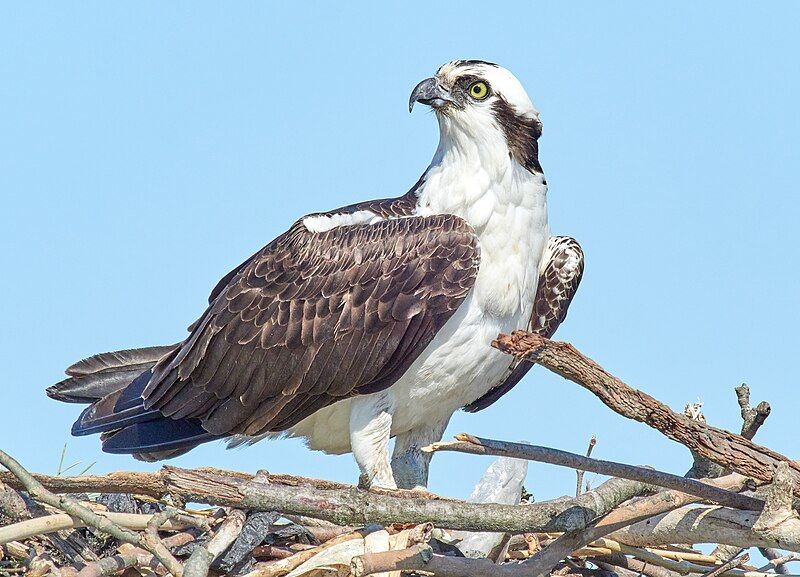
The Osprey is a large bird of prey in many parts of the world. Several names, including sea hawk, river hawk, and fish hawk, know it.
It has a brown back and grey head and chest and can grow over 60 centimeters in length with a wingspan of up to 180 centimeters. The Osprey has a daily lifestyle, meaning it is most active during the day.
Its diet consists mainly of fish, making it a formidable predator in its environment.
It has adapted specialized features for hunting and catching fish, such as reversible outer toes that allow it to grasp its prey quickly. The Osprey is a common sight near coastal areas and rivers, where it can often be seen hovering above the water in search of a meal.
It is also well known for its impressive flight maneuvers, such as its high-speed dives to capture prey. The Osprey is an integral part of the ecosystem in many parts of the world, helping to keep fish populations in check.
It is also popular with birdwatchers, who can admire the bird’s majestbird’sght and graceful hunting skills.
| Kingdom | Animalia |
| Phylum | Chordata |
| Class | Aves |
| Order | Accipitriformes |
| Family | Pandionidae |
| Genus | Pandion |
| Species | P. haliaetus |
16. Swifts
The swifts are a family of birds known as Apodidae. They are known for their impressive aerial abilities and are often mistaken for swallows due to their superficial similarities.
However, it is essential to note that swifts are not closely related to any passerine species, which are birds that are part of the large order of Passeriformes. Instead, swifts are part of the order of Apodiformes, including hummingbirds.
This order is characterized by their small size, short bills, and wings adapted for sustained flight. Swifts are some of the most aerial birds in the world and can reach speeds of up to 106 km/h when in flight.
They are also known for their long migrations, often spending long periods in the air in flight between their nesting and feeding grounds.
| Kingdom | Animalia |
| Phylum | Chordata |
| Class | Aves |
| Clade | Strisores |
| Order | Apodiformes |
| Family | Apodidae |
17. Guineafowls
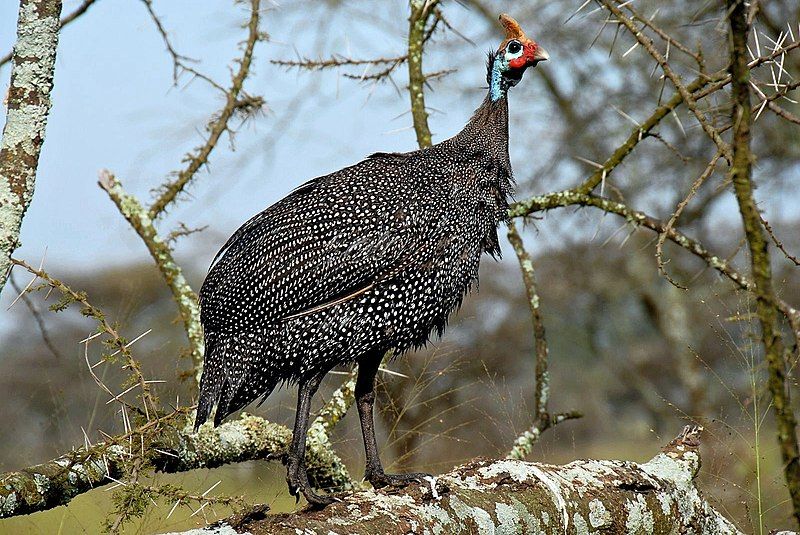
Guineafowl are birds in the family Numididae, which is part of the order Galliformes. This order includes other birds, such as grouse, quail, and pheasants. Guineafowl are found only in Africa; their history goes back to prehistoric times.
Scientists believe that guineafowl evolved from the core Galliformes, which is the category that includes most of the birds in the order Galliformes.
The guineafowl branched off from this group after the Cracidae, which includes birds such as curassows and guans, and before the Odontophoridae, which provides for quail and other small game birds.
Thus, guineafowl is a unique and ancient bird species that has been a part of the African landscape for centuries.
| Kingdom | Animalia |
| Phylum | Chordata |
| Class | Aves |
| Order | Galliformes |
| Family | Numididae |
18. Grebes
Grebes are a type of aquatic bird found in the order Podicipediformes. They are found in freshwater and marine habitats and can migrate between them. Grebes are a diverse species and can mainly fly, with some exceptions.
Some grebes, such as those found in lakes, have lost the ability to fly over time. Grebes can be found in various habitats, including wetlands, ponds, lakes, rivers, and the ocean.
They are also adept swimmers and can dive deep below the water’s surfawater’search for food. Grebes’ uniquGrebes’my allows them to be well-adapted to their aquatic environment.
They have webbed feet, which help them to swim and maneuver easily in the water. Grebes also have waterproof feathers, which allow them to stay warm and dry in the water. Grebes use their wings to help them swim and can move quickly and efficiently through the water.
| Kingdom | Animalia |
| Phylum | Chordata |
| Class | Aves |
| Clade | Mirandornithes |
| Order | Podicipediformes |
| Family | Podicipedidae |
19. Saddle-billed Stork
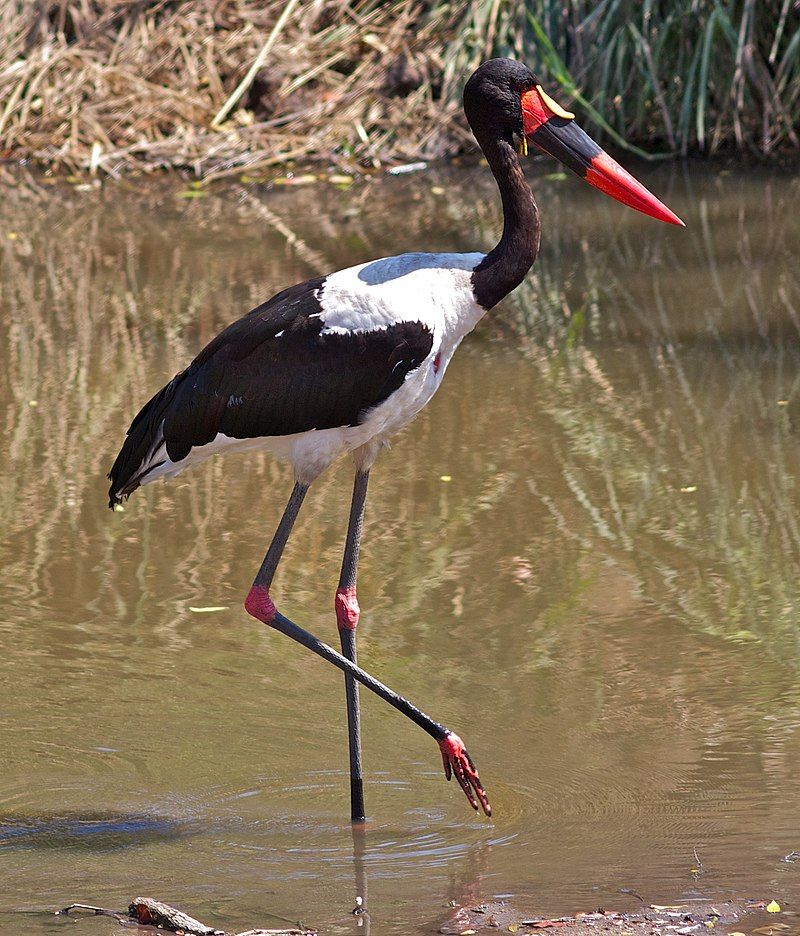
The saddle-billed stork, or saddlebill, is a species of wading bird belonging to Ciconiidae, also known as the stork family.
This stork species is found in many parts of sub-Saharan Africa, including Sudan, Ethiopia, Kenya, South Africa, The Gambia, Senegal, Côte d’Ivoire, and Chad.
It is a resident breeder in these regions, meaning it does not migrate but maintains a permanent residence in its habitat. The saddle-billed stork has a distinct appearance that is immediately recognizable.
It is a large bird, standing up to four feet tall and weighing up to nine pounds. Its most distinct feature is its long, dagger-shaped bill, which is yellow and black.
The neck and head of the saddle-billed stork are also black with a red patch on the crown, while its wings are white with a dark edge. The underparts of the stork are white, and its legs are bright red.
The saddle-billed stork is a carnivore, typically feeding on small reptiles, amphibians, crustaceans, and insects. It is also known to scavenge carrion on occasion. This stork species typically nests in tall trees, often near water, where they lay two to three eggs.
The stork will incubate the eggs for around a month before the chicks hatch. The saddle-billed stork is listed as a species of most minor concern by the International Union for Conservation of Nature due to its wide distribution and stable population.
However, habitat loss still threatens it due to human activities such as logging and agriculture.
| Kingdom | Animalia |
| Phylum | Chordata |
| Class | Aves |
| Order | Ciconiiformes |
| Family | Ciconiidae |
| Genus | Ephippiorhynchus |
| Species | E. senegalensis |
20. African Fish Eagle
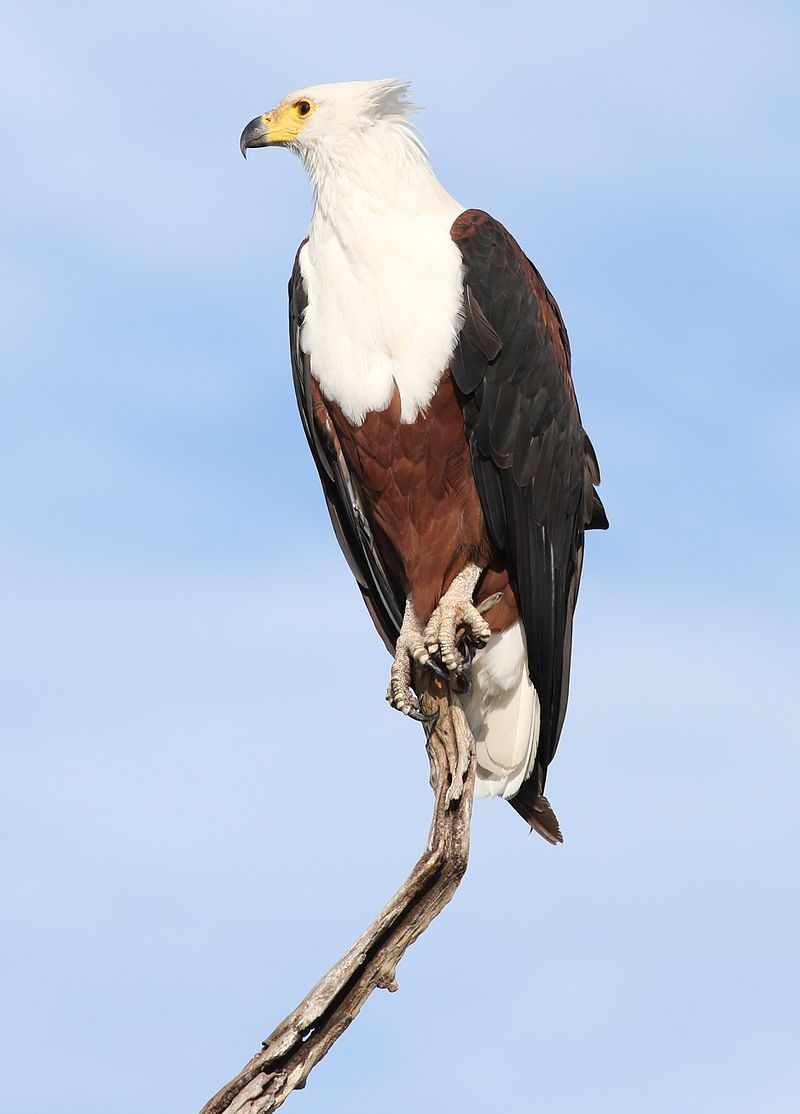
The African fish eagle, or African sea eagle, is a species found throughout sub-Saharan Africa. It is an impressive bird with a wingspan of up to 2 meters. It is a scavenger and prefers to live near open water bodies with abundant food.
This makes it a familiar sight to the region’s people. It is the national bird of four countries: Malawi, Namibia, Zambia, and Zimbabwe. As a result of its wide range, it has been given many names in different languages.
In English, it is often called the African fish eagle or the African sea eagle. In Swahili, it is known as “mwezi mwitu,” which means “forest eagle” and”
In other la” gauges, such as Afrikaans, it is known as “visited,” wh” ch means “fish eagle,” while in Nd “bele, it is called “mhukutu,” wh” ch means “the diver.”
| Kingdom | “ingdom |
| Phylum | Chordata |
| Class | Aves |
| Order | Accipitriformes |
| Family | Accipitridae |
| Genus | Icthyophaga |
| Species | I. vocifer |
21. Hottentot teal
The blue-billed teal is a dabbling duck species belonging to the genus Spatula. It is a migratory bird that is found across eastern and southern Africa, from Sudan and Ethiopia in the west to Niger and Nigeria in the north and south to South Africa and Namibia.
However, this species is sedentary in West Africa and Madagascar, meaning it does not migrate and stays in the same area year-round.
It is also known as the spotted teal or Hottentot teal. The blue-billed teal is a small duck with a blue bill, a brownish-gray head, and a black and white striped neck. Its body is mainly brown and white, with a light gray chest and darker wings.
It is a strong flier and an agile swimmer, and it usually feeds on aquatic plants and small invertebrates. Due to its wide range and abundant population, the blue-billed teal is a minor concern on the IUCN Red List.
This means the species is not threatened or endangered, and its population is in good condition. However, it is still susceptible to human activities such as hunting and habitat destruction.
Conservation efforts are necessary to ensure that the blue-billed teal continues to thrive in its natural range.
| Kingdom | Animalia |
| Phylum | Chordata |
| Class | Aves |
| Order | Anseriformes |
| Family | Anatidae |
| Genus | Spatula |
| Species | S. hottentota |
22. Long-crested Eagle
The long-crested eagle is a majestic bird of prey found in Africa. It is part of the Accipitridae family, a group of birds that includes hawks, kites, and eagles.
The long-crested eagle is the only bird within its genus, Lophaetus, and is distinguished by its unique feathers, which form a shaggy crest. The long-crested eagle is a formidable hunter, preying on small mammals, insects, and reptiles.
Its shaggy crest is thought to help it spot prey from a distance and to make it appear larger and more intimidating when hunting. The long-crested eagle is an integral part of African ecosystems and is one of the continent’s most powerful birds of prey.
| Kingdom | Animalia |
| Phylum | Chordata |
| Class | Aves |
| Order | Accipitriformes |
| Family | Accipitridae |
| Genus | Lophaetus |
| Species | L. occipitalis |
23. Hamerkop
The hamerkop is a medium-sized wading bird that belongs to the Pelecaniformes order. It is the only living species in the genus Scopus and the family Scopidae.
This species and its family were believed to be part of the Ciconiiformes order until recent research suggested that it was more closely related to the pelicans and the shoebill.
Most scientists have accepted this new placement of the hamerkop, and it is now seen as part of the Pelecaniformes order. The hamerkop is a solitary bird that typically inhabits the banks of rivers, streams, and wetlands.
It feeds mainly on fish, frogs, crabs, and other small animals. Its wings are short and rounded, and its legs are long and adapted for wading.
It has a unique, humped-back appearance, and its head is adorned with a thick crest of feathers. The hamerkop is an intriguing species and an essential part of the ecological balance in its natural habitat.
Its presence helps to maintain the balance of the food web, and its unique behavior and habitat preferences make it an interesting species to study.
| Kingdom | Animalia |
| Phylum | Chordata |
| Class | Aves |
| Order | Pelecaniformes |
| Family | Scopidae |
| Genus | Scopus |
| Species | S. umbretta |
Conclusion
Birds in Nakuru are a beautiful sight to behold. With its wide variety of species, it is an excellent destination for birdwatching. Even though some birds may be endangered, the local community is doing its best to protect them and their habitats.
Nakuru is home to many species of birds, which can be observed in their natural environment, providing a unique experience for both locals and visitors alike.